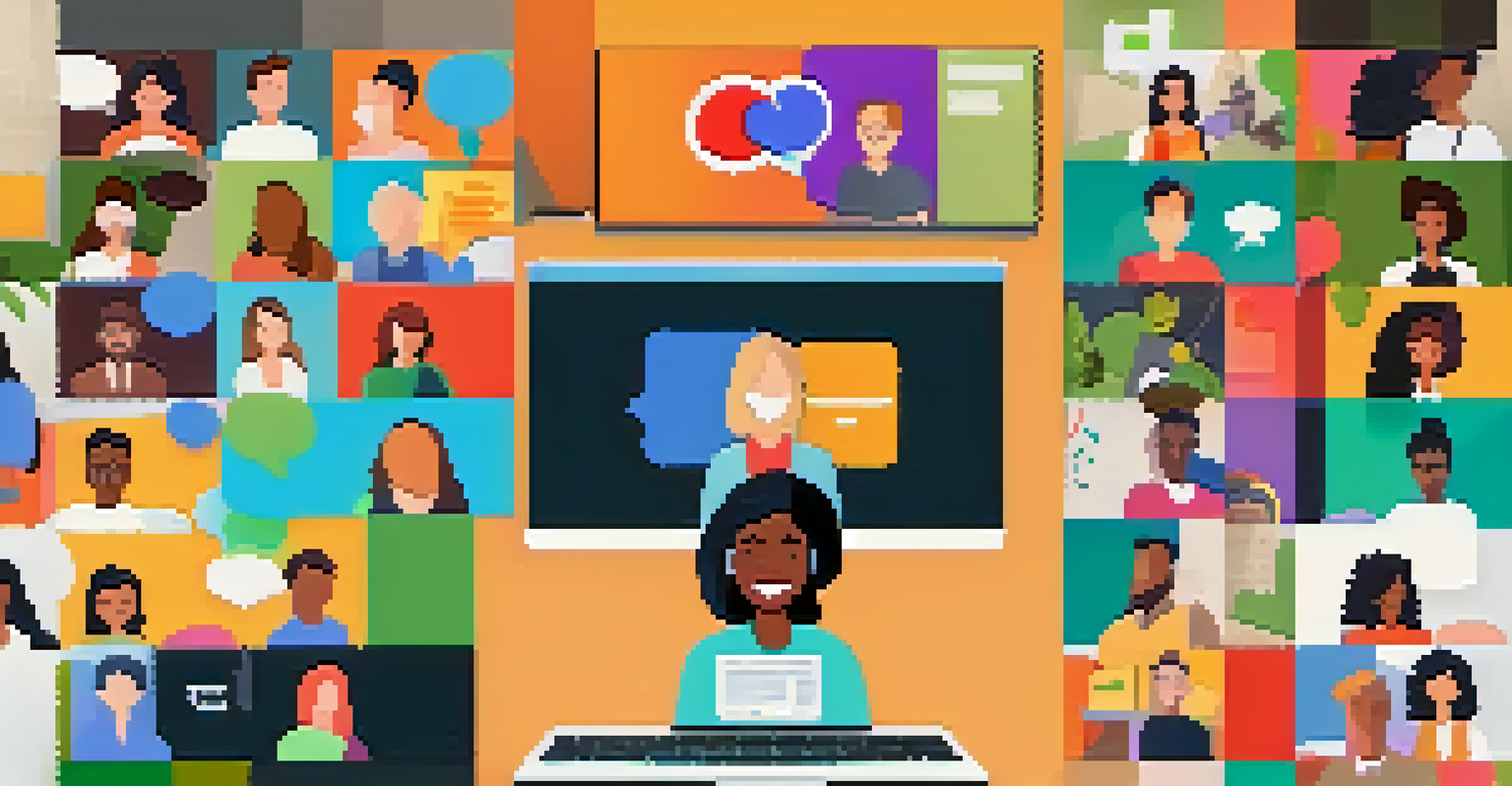The Role of Community in Promoting Social Learning

Understanding Social Learning and Its Importance
Social learning is a concept that emphasizes learning through observation and interaction with others. It’s not just about absorbing information; it’s about engaging with peers and sharing experiences. This method can lead to deeper understanding and retention of knowledge, making it an essential part of personal and professional development.
The greatest learning comes from the greatest diversity.
In a world that’s increasingly interconnected, the role of social learning becomes even more crucial. When individuals come together within a community, they can exchange ideas, challenge each other’s perspectives, and collaborate on problem-solving. This dynamic environment encourages creativity and innovation.
Moreover, social learning promotes a sense of belonging and support. When people feel connected to a community, they are more likely to take risks in their learning journey, knowing they have a safety net. This supportive network is vital for fostering resilience and confidence in both personal and academic pursuits.
The Power of Shared Experiences in Learning
Shared experiences within a community can significantly enhance the learning process. Whether through workshops, group projects, or informal gatherings, these interactions create a rich tapestry of knowledge. When individuals share their stories, they provide unique insights that others may not have considered.

For instance, consider a cooking class where participants not only learn recipes but also share personal cooking tips and cultural anecdotes. This exchange not only enriches the learning experience but also fosters a deeper connection among participants. Such interactions can transform a simple class into a vibrant community of learners.
Social Learning Enhances Understanding
Engaging with peers through observation and interaction not only deepens knowledge retention but also fosters creativity and innovation.
Furthermore, shared experiences can help demystify complex concepts. When learners encounter challenges, discussing these hurdles within a community can lead to collaborative solutions. This collective problem-solving approach often results in a more profound understanding of the subject matter.
Creating a Supportive Learning Environment
A supportive community is crucial for effective social learning. When members feel safe to express their thoughts and questions, it encourages open dialogue and exploration. This environment allows for mistakes to be seen as learning opportunities rather than failures.
Learning is a social process, and the best way to learn is to share experiences with others.
Consider a study group where all members are encouraged to contribute. Each person’s contribution, no matter how small, is valued, creating a sense of ownership and responsibility. This collaborative spirit not only boosts morale but also enhances motivation and commitment to the learning objectives.
Moreover, when communities celebrate individual and collective achievements, it reinforces positive behavior and encourages continuous learning. Recognition can be a powerful motivator, inspiring others to engage and participate actively in their educational journeys.
Diversity and Its Role in Enhancing Learning
Diversity within a community can greatly enrich the social learning process. Different backgrounds, experiences, and perspectives contribute to a more holistic understanding of various subjects. This diversity encourages learners to think critically and approach problems from multiple angles.
For example, in a community comprised of individuals from various cultures, discussions can lead to a broader appreciation of global issues. Members can share different viewpoints, fostering empathy and understanding. This exchange not only enhances learning but also prepares individuals for a more interconnected world.
Supportive Communities Boost Learning
A safe and encouraging environment allows members to express themselves freely, turning mistakes into valuable learning opportunities.
Additionally, diverse communities can challenge biases and assumptions. When learners are exposed to differing opinions, it encourages them to reflect on their own beliefs and expand their horizons. This critical engagement is essential for personal growth and developing a well-rounded worldview.
Leveraging Technology to Foster Community Learning
In today’s digital age, technology plays a pivotal role in fostering community-based social learning. Online platforms and social media allow individuals to connect with others around the globe, breaking down geographical barriers. This accessibility opens up a wealth of resources and perspectives that enhance the learning experience.
For instance, online forums and discussion groups enable learners to engage in conversations that they might not have in a traditional classroom setting. These digital spaces can amplify voices and create inclusive environments where all participants feel valued. Such interactions can lead to meaningful collaborations and knowledge sharing.
Moreover, technology can facilitate mentorship opportunities within communities. Experienced individuals can offer guidance and support to newcomers, further enriching the learning experience. This mentorship not only benefits the mentees but also reinforces the mentor’s knowledge and skills.
The Role of Leadership in Community Learning
Effective leadership is essential in nurturing a thriving community focused on social learning. Leaders set the tone for the group, fostering an environment that encourages participation and collaboration. Their role is not just to guide but also to inspire members to take ownership of their learning journeys.
Good leaders actively listen to the needs and concerns of their community members. By fostering open communication, they can adapt their approaches to better serve the group. This responsiveness builds trust and respect, essential ingredients for a successful learning community.
Diversity Enriches Learning Experiences
Exposure to different perspectives in a diverse community promotes critical thinking and empathy, preparing individuals for a globalized world.
Furthermore, leaders can create opportunities for professional development within the community. By organizing workshops, guest speakers, and collaborative projects, they can ensure that learning remains dynamic and engaging. This proactive approach keeps the community vibrant and encourages ongoing participation.
Measuring the Impact of Community on Learning Outcomes
To truly understand the role of community in promoting social learning, it’s important to measure its impact on learning outcomes. This can be achieved through surveys, feedback sessions, and performance assessments. By gathering data, communities can identify what works well and where improvements are needed.
For instance, a community might track participation rates in discussions and correlate them with individual learning achievements. This data can reveal how collaborative efforts contribute to overall success. Understanding these dynamics allows communities to refine their approaches and better support their members.

Additionally, measuring success can inspire continued engagement. When community members see tangible results from their collective efforts, it reinforces the value of collaboration and learning together. This cyclical process of feedback and improvement keeps the community thriving and focused on shared goals.